You searched for: 谷歌开户竞价推广包上【TG飞机:@bapingseo】东京大学谷歌排名【TG电报:@bapingseo】上海Google优化【Telegram:@bapingseo】创世红海彩票邀请码吗滚球让2球凯撒斗牛苹果?2bCbK6/wT8LaG.html
<< Previous | Displaying results 11-20 of 348 for "谷歌开户竞价推广包上【TG飞机:@bapingseo】东京大学谷歌排名【TG电报:@bapingseo】上海Google优化【Telegram:@bapingseo】创世红海彩票邀请码吗滚球让2球凯撒斗牛苹果?2bCbK6/wT8LaG.html" | Next >>
-
Telegram from Quanza Passengers to Eleanor Roosevelt
PhotoThe SS Quanza was a Portuguese ship chartered by Jewish refugees attempting to escape Nazi-dominated Europe in August 1940. Passengers with valid visas were allowed to disembark in New York and Vera Cruz, but that left 81 refugees seeking asylum. On September 10, 1940, they sent this telegram to First Lady Eleanor Roosevelt to implore her for help.
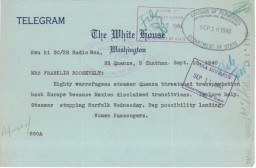
-
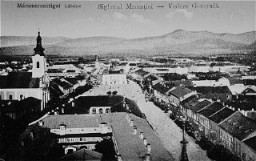
-
Headphones
ArtifactHeadphones used by defendant Albert Speer during the International Military Tribunal. Headphones like these enabled trial participants to hear simultaneous translation of the proceedings.

-
Second telegram from the Chief Rabbi of Vilna asking for aid
DocumentA second RCA Radiogram telegram from Rabbi Grodzenski, Chief Rabbi of Vilna, to the Central Relief Committee in New York. He requests aid for refugees who have gathered in Vilna. The telegram says that more than 1,600 yeshiva students and their families from over 10 cities throughout Poland have fled to Vilna, where they remain in terrible living conditions. November 5, 1939. [From the USHMM special exhibition Flight and Rescue.]
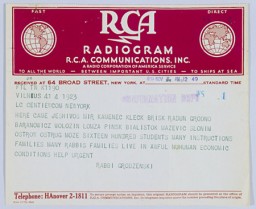
-
Book burning in Berlin
PhotoBooks and writings deemed "un-German" are burned at the Opernplatz (Opera Square). Berlin, Germany, May 10, 1933.
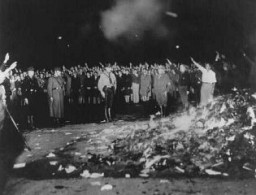
-
Arriving in New York
PhotoChildren aboard the President Harding look at the Statue of Liberty as they pull into New York harbor. They were brought to the United States by Gilbert and Eleanor Kraus. New York, United States, June 1939.
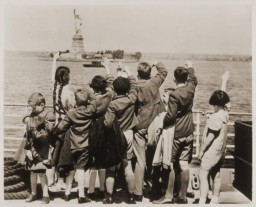
-
Conditions in the Warsaw ghetto
FilmThe Nazis sealed the Warsaw ghetto in mid-November 1940. German-induced overcrowding and food shortages led to an extremely high mortality rate in the ghetto. Almost 30 percent of the population of Warsaw was packed into 2.4 percent of the city's area. The Germans set a food ration for Jews at just 181 calories a day. By August 1941, more than 5,000 people a month succumbed to starvation and disease.
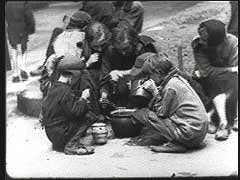
-
Hannah Szenes
PhotoHannah Szenes on her first day in Palestine. Haifa, Palestine, September 19, 1939. Between 1943 and 1945, a group of Jewish men and women from Palestine who had volunteered to join the British army parachuted into German-occupied Europe. Their mission was to organize resistance to the Germans and aid in the rescue of Allied personnel. Hannah Szenes was among these volunteers. Szenes was captured in German-occupied Hungary and executed in Budapest on November 7, 1944, at the age of 23.
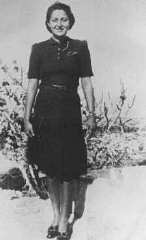
-
Armenian refugees
PhotoRefugees foraging at Alexandropol, Russian Armenia. Photograph taken by John Elder. In 1917, Elder, a divinity student from Pennsylvania, joined the American Committee for Armenian and Syrian Relief team that was aiding refugees. For two years, Elder did volunteer work with Armenian orphans. During that time, he photographed refugees and conditions at camps.

-
Belle Mayer Zeck describes working conditions and staffing at Nuremberg during the postwar trials
Oral HistoryBelle Mayer trained as a lawyer and worked for the General Counsel of the US Treasury, Foreign Funds Control Bureau. This bureau worked to enforce the Trading With the Enemy Act passed by Congress. In this capacity, Mayer became familiar with the German I. G. Farben chemical company, a large conglomerate that used slave labor during World War II. In 1945, Mayer was sent as a Department of Treasury representative to the postwar London Conference. She was present as representatives from the Allied nations…

